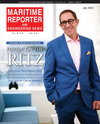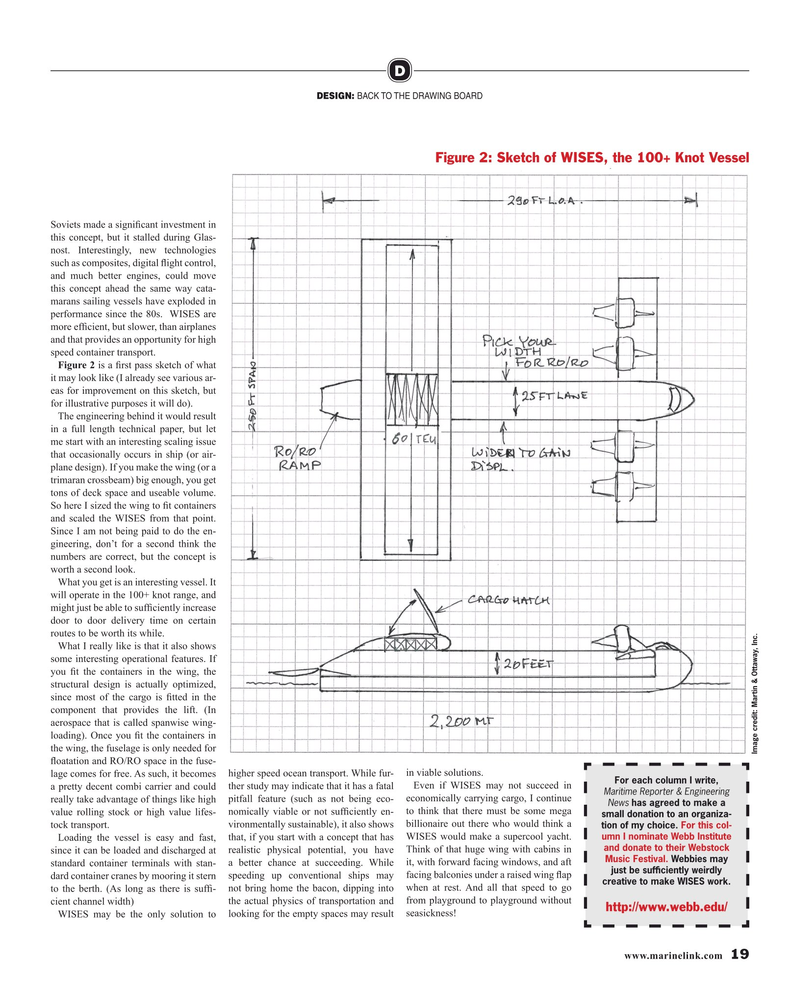
Page 19: of Maritime Reporter Magazine (July 2019)
Cruise Vessel Design & Outfit
Read this page in Pdf, Flash or Html5 edition of July 2019 Maritime Reporter Magazine
D
DESIGN: BACK TO THE DRAWING BOARD
Figure 2: Sketch of WISES, the 100+ Knot Vessel
Soviets made a signifcant investment in this concept, but it stalled during Glas- nost. Interestingly, new technologies such as composites, digital fight control, and much better engines, could move this concept ahead the same way cata- marans sailing vessels have exploded in performance since the 80s. WISES are more effcient, but slower, than airplanes and that provides an opportunity for high speed container transport.
Figure 2 is a frst pass sketch of what it may look like (I already see various ar- eas for improvement on this sketch, but for illustrative purposes it will do).
The engineering behind it would result in a full length technical paper, but let me start with an interesting scaling issue that occasionally occurs in ship (or air- plane design). If you make the wing (or a trimaran crossbeam) big enough, you get tons of deck space and useable volume.
So here I sized the wing to ft containers and scaled the WISES from that point.
Since I am not being paid to do the en- gineering, don’t for a second think the numbers are correct, but the concept is worth a second look.
What you get is an interesting vessel. It will operate in the 100+ knot range, and might just be able to suffciently increase door to door delivery time on certain routes to be worth its while.
What I really like is that it also shows some interesting operational features. If you ft the containers in the wing, the structural design is actually optimized, since most of the cargo is ftted in the component that provides the lift. (In aerospace that is called spanwise wing- loading). Once you ft the containers in the wing, the fuselage is only needed for
Image credit: Martin & Ottaway, Inc.
foatation and RO/RO space in the fuse- lage comes for free. As such, it becomes higher speed ocean transport. While fur- in viable solutions.
For each column I write, a pretty decent combi carrier and could ther study may indicate that it has a fatal Even if WISES may not succeed in
Maritime Reporter & Engineering really take advantage of things like high pitfall feature (such as not being eco- economically carrying cargo, I continue
News has agreed to make a value rolling stock or high value lifes- nomically viable or not suffciently en- to think that there must be some mega small donation to an organiza- vironmentally sustainable), it also shows billionaire out there who would think a tock transport.
tion of my choice. For this col- umn I nominate Webb Institute
Loading the vessel is easy and fast, that, if you start with a concept that has WISES would make a supercool yacht. and donate to their Webstock since it can be loaded and discharged at realistic physical potential, you have Think of that huge wing with cabins in
Music Festival. Webbies may a better chance at succeeding. While it, with forward facing windows, and aft standard container terminals with stan- just be suffciently weirdly dard container cranes by mooring it stern speeding up conventional ships may facing balconies under a raised wing fap creative to make WISES work. not bring home the bacon, dipping into when at rest. And all that speed to go to the berth. (As long as there is suff- the actual physics of transportation and from playground to playground without cient channel width) http://www.webb.edu/
WISES may be the only solution to looking for the empty spaces may result seasickness! www.marinelink.com 19

 18
18

 20
20
